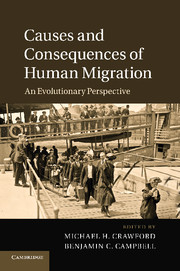Book contents
- Frontmatter
- Contents
- Contributors
- Preface
- 1 Perspectives on human migration: introduction
- Section 1 Theory
- Section 2 Geography and migration
- 8 Population structure and migration in Africa: correlations between archaeological, linguistic, and genetic data
- 9 Human migrations in North Africa
- 10 Identity, voice, community: new African immigrants to Kansas
- 11 The African colonial migration into Mexico: history and biological consequences
- 12 Demic expansion or cultural diffusion: migration and Basque origins
- 13 Consequences of migration among the Roma: immunoglobulin markers as a tool in investigating population relationships
- 14 Migration, assimilation, and admixture: genes of a Scot?
- 15 Mennonite migrations: genetic and demographic consequences
- 16 Human migratory history: through the looking-glass of genetic geography of Mycobacterium tuberculosis
- 17 Peopling the Tibetan plateau: migrants, genes, and genetic adaptations
- 18 Migration, globalization, instability, and Chinese in Peru
- 19 The great blue highway: human migration in the Pacific
- 20 Migration of pre-Hispanic and contemporary human Mexican populations
- 21 A review of the Tupi expansion in the Amazon
- 22 Molecular consequences of migration and urbanization in Peruvian Amazonia
- 23 Migration in Afro-Brazilian rural communities: crossing historical, demographic, and genetic data
- 24 Indentured migration, gene flow, and the formation of the Indo-Costa Rican population
- 25 Causes and consequences of migration to the Caribbean Islands and Central America: an evolutionary success story
- Section 3 Overview
- Index
- References
15 - Mennonite migrations: genetic and demographic consequences
Published online by Cambridge University Press: 05 December 2012
- Frontmatter
- Contents
- Contributors
- Preface
- 1 Perspectives on human migration: introduction
- Section 1 Theory
- Section 2 Geography and migration
- 8 Population structure and migration in Africa: correlations between archaeological, linguistic, and genetic data
- 9 Human migrations in North Africa
- 10 Identity, voice, community: new African immigrants to Kansas
- 11 The African colonial migration into Mexico: history and biological consequences
- 12 Demic expansion or cultural diffusion: migration and Basque origins
- 13 Consequences of migration among the Roma: immunoglobulin markers as a tool in investigating population relationships
- 14 Migration, assimilation, and admixture: genes of a Scot?
- 15 Mennonite migrations: genetic and demographic consequences
- 16 Human migratory history: through the looking-glass of genetic geography of Mycobacterium tuberculosis
- 17 Peopling the Tibetan plateau: migrants, genes, and genetic adaptations
- 18 Migration, globalization, instability, and Chinese in Peru
- 19 The great blue highway: human migration in the Pacific
- 20 Migration of pre-Hispanic and contemporary human Mexican populations
- 21 A review of the Tupi expansion in the Amazon
- 22 Molecular consequences of migration and urbanization in Peruvian Amazonia
- 23 Migration in Afro-Brazilian rural communities: crossing historical, demographic, and genetic data
- 24 Indentured migration, gene flow, and the formation of the Indo-Costa Rican population
- 25 Causes and consequences of migration to the Caribbean Islands and Central America: an evolutionary success story
- Section 3 Overview
- Index
- References
Summary
Introduction
In recent years, advances in molecular genetics have increased the understanding of past prehistoric demographic events. Yet, few molecular genetic studies have investigated more recent human migration, such as those from religious persecution (Behar et al., 2008, 2010; Melton et al., 2010; Non et al., 2011; Pichler et al., 2010). Throughout history, religious persecution has often led to human migration; which in turn has led to unique cultural and biological factors impacting human populations. The most classic example of religious migration in the scientific literature has focused on Jewish diasporas and movement of Ashkenazi and Sephardic populations in Europe (Behar et al., 2008, 2010; Non et al., 2011). Another example is the Reformation that occurred in sixteenth-century Europe. This in turn led to the migration of several groups throughout Europe and to the Americas. This chapter provides a brief summary of the Reformation and Anabaptist movement, and then compares existing knowledge of classical genetic polymorphism and molecular genetic markers to demonstrate that molecular genetic data provide a more accurate reflection of Mennonite demographic history.
The Reformation began in 1517 when Martin Luther hammered his 95 Theses to the door of the Catholic Church in present-day Wittenburg, Germany (MacCulloch, 2003). This movement began as an attempt to reform corruption within the Catholic Church. Western European Catholics were involved with false doctrines and practices, which included selling of indulgences, forgiveness of sins, and the buying and selling of church positions. Arguments regarding the explanation of doctrine and spiritual differences among Reformation leaders led to the formation of different Protestant denominations. The most important of these denominations were the Lutherans, Calvinists, Presbyterians, and Anabaptists (MacCulloch, 2003).
- Type
- Chapter
- Information
- Causes and Consequences of Human MigrationAn Evolutionary Perspective, pp. 299 - 316Publisher: Cambridge University PressPrint publication year: 2012
References
- 1
- Cited by



